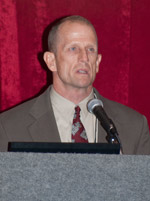General Session I
Fitting Cattle to the Environment:
Breeding Cattle in One; Raising Them in Another
Crossbreeding Brahman cattle to monitor performance from different environments in the United States.
by Kelli Fulkerson for Angus Productions Inc.
HOUSTON, Texas (April 19, 2012) — David Riley discussed the challenge of being able to breed cattle in one part of the United States and raise them in another. Riley, a professor of animal science at Texas A&M University, spoke during the opening session of the 2012 Beef Improvement Federation (BIF) Research Symposium and Annual Meeting in Houston, sharing his research findings, Brahman Crossbred Performance in Distinct Segments of the United States Beef Industry.

David Riley
Most Bos taurus cattle have a difficult time performing in the southern United States due to the predominantly subtropical climate zone, Riley said. Bos taurus cattle maintain high body temperatures and respiration rates when exposed to extreme heat conditions. This doesn’t mean that they can’t survive; however, there is opportunity for the beef industry to utilize Bos indicus cattle, which can dissipate heat more easily, and create strong crossbreeding systems, Riley said. Today, Braham-influenced cattle comprise 42% of the U.S. cow herd due to their adaptability to rough conditions and the heterosis they offer in reproductive traits.
Multiple reproductive trait studies have been conducted testing heterosis levels with Braham-Bos taurus crosses. In Florida, from 2002 to 2010, Riley conducted an experiment using straightbreds and crossbreds of Brahman, Angus and Romosinuano (Cirollo Bos taurus breed) to develop a herd of F1 females. Researchers compared the F1 females as to calving and weaning rates, calf weaning weights, and weaning weight per cow exposed to breeding in the Germplasm Evaluation (GPE). Once offspring were weaned from the F1 females, they became part of the study and were moved from the southeast to the Great Plains to test the stocker and feeder phases of the beef industry.
The stocker/feeder stage evaluated the factors of transportation/receiving, grazing on winter pasture, feedlot efficiency, intake levels and overall carcass traits.
“The calf that was doing exceptionally well in the environment it was born in, may not do as well in another,” said Riley.
It was concluded that Brahman F1 offspring struggled to perform in the feeder stage due to adverse winter conditions. Areas of feed intake, growth and marbling were substantially low in reference to economic importance. However, it was predicted that animals of ¼ Brahman would be able to handle and perform in the feedlot system of the Great Plains.
Return to the Newsroom for links to the PowerPoint presentation that accompanied this presentation.
Editor’s Note: This summary was written under contract or by staff of Angus Productions Inc. (API). Through an agreement with the Beef Improvement Federation, we are encouraging reprinting of the articles to those who will adhere to the reprint guidelines available on this site. Please review those guidelines or contact Shauna Rose Hermel, editor, at 816-383-5270. PowerPoints are posted with permission of the presenter and may not be reproduced in whole or in part without the express permission of the presenter.
API's coverage of the event is made possible through collaboration with BIF and sponsorship of LiveAuctions.tv. For questions about this site, or to notify us of broken links, click here.
Headquartered in Saint Joseph, Mo., API publishes the Angus Journal, the Angus Beef Bulletin, the Angus Beef Bulletin EXTRA, and the Angus e-List, as well as providing online coverage of events and topics pertinent to cattlemen through the API Virtual Library.



